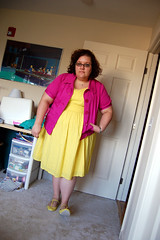Outfitblogging: The Wallflower
By Lesley | August 14, 2008



For years upon years I wore nothing but black. By this I don’t mean that I wore “a lot” of black, or that the majority of my wardrobe was black – I mean bloody everything was black. The most color you’d see on me was, maybe, if something had red stitching on it. The black was omnipresent enough that it became a sort of trademark; I was always that girl who wears black all the time. People remembered me that way. People would refer to me that way.
Black was easy. Everything matched. I could spill shit on myself (a common occurrance even today) and not worry about a stain ruining the garment forever. In a more visceral way, it was also deliciously dramatic and cosmopolitan. I will argue til I’m dead that everyone is saying something, intentional or not, with the clothes they wear – even clothes that offer camouflage or cover.
To invoke our own ever-brilliant stitchtowhere, who was quoting someone else that said:
“As a visible expression of the social order, grooming practices mark a society’s members by rank, gender, occupation, and age, and also communicate identity, affinity, or aspiration. Failure or refusal to groom communicates resistance, carelessness , or incapacity. Thus, it is never possible simply to “opt out” of the discourse of dress. No one can dress in a way that signifies nothing.” (Scott 12)
Black says that you’re Serious. Black says that you’re Not To Be Trifled With. Black simultaneously stands you out and renders you invisible.
At some point in the past few years I befriended color for the first time, really, since my childhood. To the extent that now it’s difficult for me to wear black at all, unless we’re talking about a job interview or a formal event or something requiring some other variation of a uniform. I like color – particularly bright, retina-searing color – for some of the same reasons I liked black. It’s memorable. It’s dramatic. It’s something people remember.
It’s also attention-getting. Culturally-speaking, fat bodies are earmarked as either invisible (insofar as getting no attention at all) or temporary (insofar as only getting attention as the “before” in a before-and-after, or as the warning against alleged bodily/moral iniquity lest THIS COULD BE YOU). Wearing color means making myself – and my body – visible in a forceful way. I’m almost impossible to ignore. I may be othered; but you’re going to see me no matter what, whether you like it or not. And truthfully, personally, I don’t particularly care if you do – visibility for me is only marginally connected to attractiveness, or about being seen as “pretty”. No matter my body size, no matter what my face looks like, the eye of the beholder rules the day, so in the end there will always be folk who find me unattractive or even repulsive. I can’t be arsed to worry about that, or to allow myself think it says something about me, since I can’t change it. And as is often repeated but less often heard in fat acceptance circles: you don’t have to be “pretty”. You don’t owe attractiveness to anyone.
No, for me visibility is – literally, simply – about being seen. Seen, as the great big fatass I am, contented and proud in my own skin; this is a miserably uncommon representation of fat people, and yet I know these folk exist, because here I am. And here are my fat friends who feel similarly. Where are we represented, where are our experiences reproduced? If I can’t see them in culture, I will represent them myself.
I wouldn’t argue that all fat people should demand attention. I wouldn’t prescribe behavior to anyone unless they were comfortable with it. I am mostly asking you to consider what you’re saying with the clothes you wear, with your style, or lack thereof. Is it you? Or is it what the cultural discourse says you should be?
Comments are closed.





 Two Whole Cakes is a blog written by
Two Whole Cakes is a blog written by 

